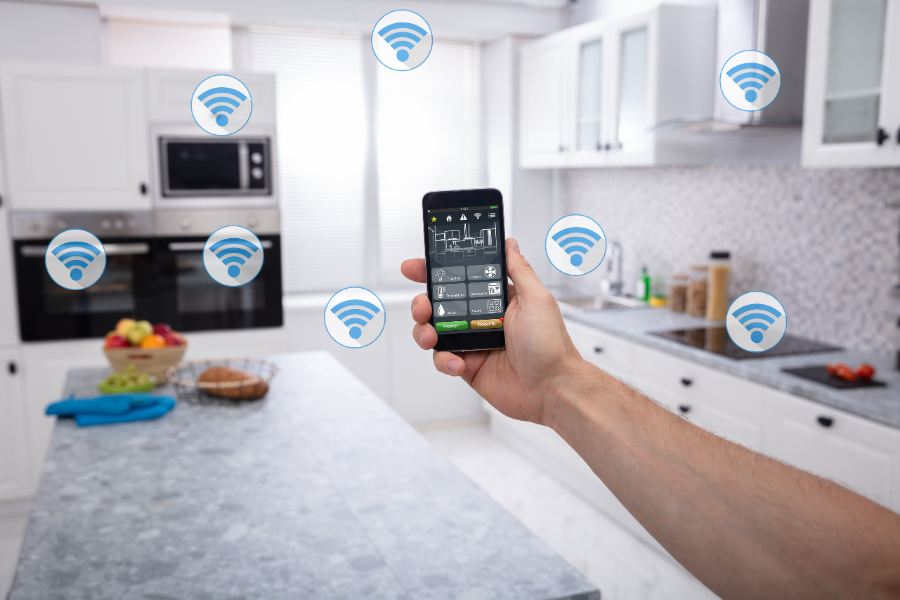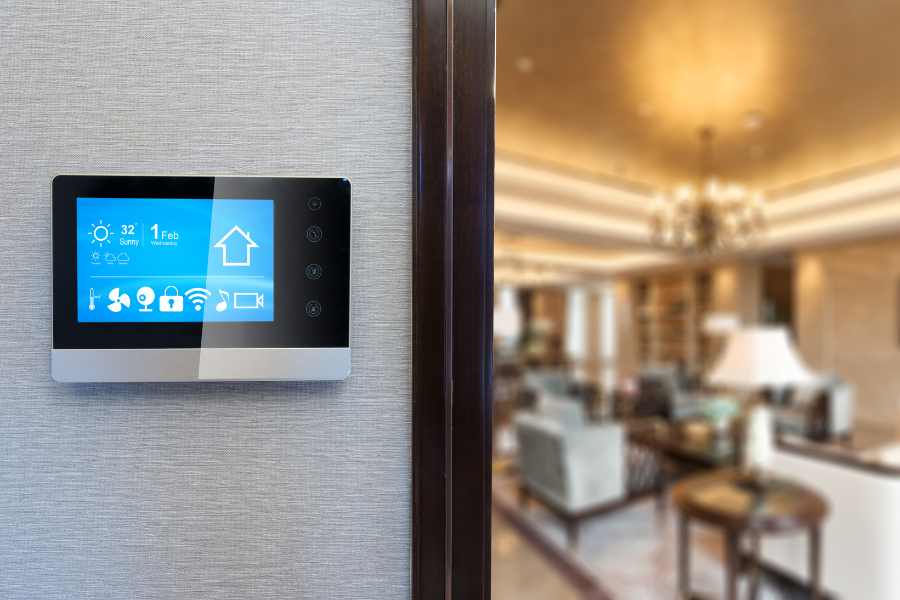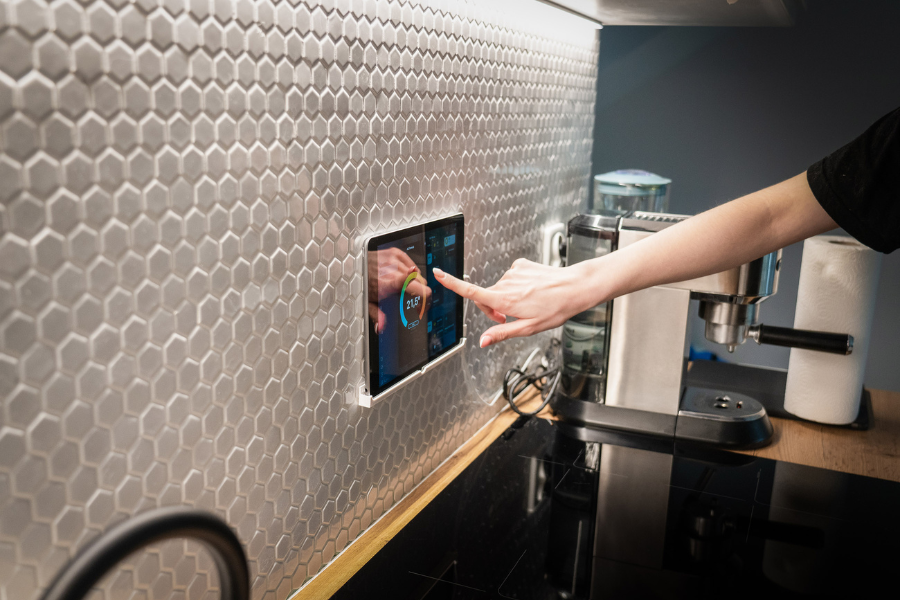HOT OFFER! Save $180 on selected internet plans + get beIN SPORTS CONNECT included!...Use promo code BEIN30 at checkout! Hurry, limited time only!
Transforming Your House into a Smart Home: The Essential Guide
Home & Lifestyle Blog | MATE | 13 February 2024

The surge in smart home automation technology has transformed the way we live, offering unparalleled convenience and efficiency. Here, we take a closer look at smart homes, exploring what they are, how they function, and their advantages and disadvantages. Whether you’re a tech-savvy DIY enthusiast or just curious about this technological revolution, you’re in the right place to discover everything about smart homes and their growing relevance in our daily lives.
What is a smart home?
In recent years, the term “smart home” has become a buzzword. But what does it actually mean, and what makes an automated smart home?
Smart home definition
A smart home refers to a residence equipped with devices and appliances that automate tasks normally handled by humans. These devices are connected to the internet and can be remotely controlled using a mobile phone or any other networked smart device.
This automation in a smart home is not just about technological convenience but also about making your home more energy-efficient and secure.
Key components of a smart home
What turns a house into a true smart home? For one, a smart home typically comprises a variety of smart gadgets and devices. This can include devices and appliances such as:
- Smart lights that can be programmed to switch on and off at specific times.
- A smart fridge that allows you to create a shopping list you can access while you’re at the grocery store.
- A smart air conditioner that you can program to warm up or cool down your home, even when you’re out of the house.
But it’s not just about these individual devices and how they function. It’s about how they all interconnect and communicate with each other. For instance, a smart speaker (such as Google Nest or Amazon Echo) can act as a hub for your smart home, allowing you to control your other devices through the use of voice commands. These smart home features aim to add convenience, comfort, and security, revolutionising how we interact with our living spaces.
Smart home automation and controls: How it works
Automation and control are the backbones of smart home technology. Through app and voice control, users can manage their home environments effortlessly.
The main benefit of having a smart home set up is the convenience it offers you. You can even set up routines for your smart home that you can control with a simple voice command.
Let’s say you set up a routine using your smart assistant of choice (such as Google Assistant, Alexa or Siri) to activate in the morning when you get up out of bed. When you say a key phrase, like “Run the good morning routine” to your smart speaker, it will begin running your customised routine. This could involve turning on the lights in the house, turning on the air conditioner at a pre-set temperature, and then having the smart assistant communicate the day’s weather and the top news headlines of the morning to you.
Another example could be enabling an entertainment routine, such as a movie night routine. When you say the key phrase out loud to your smart speaker, this will be the signal to turn on your smart television, dim your smart lights, and have your smart assistant give you a list of the most popular movies available on your favourite streaming app.
Smart home security
Having a smart home is not just about convenience and comfort. It can also be about security and peace of mind. Features like remote door locks, surveillance cameras, and motion sensors can all be managed from your smartphone, offering peace of mind whether you’re home or away. Even your smart garage door can be integrated into this system, allowing for remote operation and monitoring.
The role of IoT in Smart Homes
The Internet of Things (IoT) is a cornerstone of smart homes. IoT encompasses a network that connects everyday objects, devices, and technologies—the ‘things’ that make up the Internet of Things. These smart ‘things’ are capable of communicating and sharing data with other devices over the internet, which allows them to interact with one another and perform tasks without being physically adjusted.In the context of a smart home, IoT plays a pivotal role in ensuring that connected devices, such as smart home appliances, smart lights and other devices, can communicate with each other and be controlled remotely.
These connected devices form an ecosystem where they work together, offering enhanced living experiences. For example, a smart thermostat can learn your schedule and adjust the temperature accordingly, or a smart fridge can notify you when you’re running low on essentials. This interconnectedness is what makes a house a smart home.

The advantages and disadvantages of smart homes
Giving your house a futuristic upgrade and turning it into a connected smart home has plenty of benefits. However, there are some downsides, and it’s important to consider both smart home pros and cons before you make any decisions.
Top 5 smart home pros
In a world where efficiency, security, and convenience are prized, smart homes offer these benefits in spades, revolutionising the way we live and interact with our living spaces. Here are the top 5 pros of setting up a smart home:
1. Convenience
One of the primary benefits of a smart home is the sheer convenience it offers. The ability to control various aspects of your home environment, whether through a smartphone app or voice commands via a smart assistant, simplifies daily routines and tasks. Ultimately, this makes life easier by saving you time and stress.
2. Energy efficiency
Smart homes significantly contribute to energy conservation. With smart thermostats and smart lights, you can easily regulate energy usage, reducing consumption and the cost of your utility bills.
3. Enhanced security
Safety is a major concern for many, and smart homes excel in this area. Smart devices like security cameras, smart locks, and alarm systems provide real-time monitoring and instant alerts, enhancing the safety of your home. This heightened security brings peace of mind, knowing your home is protected even when you’re away.
4. Efficiency in daily tasks
Smart home appliances add another layer of efficiency to your lifestyle. Imagine being able to preheat your oven remotely or receive maintenance notifications from your appliances. These features streamline household chores, saving time and reducing the mental load of daily life management.
5. Centralised control
Integrating various devices under one central control system is a standout feature of smart homes. This unified management system allows you to control and monitor multiple functions, from home security to lighting, offering a seamless, integrated home experience.
Potential smart home cons
While smart homes offer a world of benefits, these potential drawbacks are important to consider. Looking at both the pros and cons of setting up a smart home will ensure that you make the right decision that fits your lifestyle. Here are a few smart home cons to be aware of:
Privacy concerns
A notable drawback of smart homes is the potential risk to privacy. Since smart devices are connected to the internet, there’s a risk that personal information and data could be vulnerable to breaches or hacking, raising concerns about the safety of sensitive information.
Dependency on technology
Relying heavily on technology can be a double-edged sword. In smart homes, there is a risk of becoming overly dependent on automated systems. If these systems fail or if there’s a loss of internet connectivity, it can lead to significant inconveniences, highlighting a dependency that might be hard to manage in tech disruptions.
Initial setup costs and ongoing maintenance
Setting up a smart home often involves a substantial initial investment. You will also need to consider the ongoing costs of running your smart devices and make time for regular updates and maintenance.
Setting up your smart home: What to consider
Ok, so now you’ve considered the pros and cons of a smart home, and have decided that you want to begin transforming your house into a home of the future. Before you jump right in, here are a few steps to follow to ensure the smooth set up and running of your smart home.
Choosing the right smart home gadgets and devices
When setting up a smart home, the first step is choosing the right devices that meet your needs and lifestyle. Choosing the right smart home devices is important because it can greatly influence your overall experience and satisfaction with your smart home.
The key to a successful setup lies in selecting devices that align with your specific needs and lifestyle. Think about the following aspects before you purchase your first smart devices:
Personalisation and relevance
Every household has unique needs. For instance, a family with young children might prioritise smart home security systems, while a tech enthusiast might focus on smart home appliances and entertainment systems. Choosing devices that cater to your specific requirements ensures that your smart home truly enhances your daily life.
Ease of use and management
User-friendly devices that match your tech comfort level are crucial. Overly complicated systems can lead to frustration, reducing the convenience that a smart home is supposed to offer. Choosing devices with intuitive interfaces and simple controls can enhance your experience significantly.
Budget considerations
Smart home technology varies in price. It’s important to select devices that fit your budget while still meeting your needs. This balance ensures that you get the best value without overspending on unnecessary features.
Future scalability
As technology evolves, so might your needs. Opting for smart devices that can be easily upgraded or integrated with newer technologies ensures your smart home remains up-to-date and adaptable to future innovations.
Ultimately, the goal of a smart home is to enhance your lifestyle, whether it’s through increased security, improved convenience, or better energy management. Choosing the right devices ensures that your smart home fulfils this goal, making everyday tasks easier and your home more comfortable and secure.
Assessing your internet network capabilities
Before setting up a smart home, assess your home’s wifi network and internet connectivity. A strong and stable wifii network is essential for the smooth operation of smart devices. Upgrading to a fast nbn plan that is capable of supporting multiple devices, such as MATE’s Fair Dinkum home nbn plan, could be the answer if your current plan is not up to the task.
You should also consider the range of your wifi signal and whether it extends to all areas of your home where you plan to use smart devices. If not, you might need to consider investing in a mesh wifi system.
Security and data protection
With the increasing number of smart home devices connected to the internet, it’s crucial to consider the security of your home network. Ensure that you have solid security measures in place, like strong passwords and regular software updates, to protect against potential cyber threats. An understanding of cybersecurity measures is important to have, especially for children. Teaching young kids about cybersecurity can help to keep them safe online, and help protect the privacy of all household members.

Smart devices: What’s available?
Smart home devices have come a long way, offering an array of functionalities to enhance our daily lives. Some of the most popular examples, as we’ve already mentioned, include smart speakers and their integrated smart assistants, as well as smart lights and smart security devices.
But smart home tech tools go well beyond these. Here are just a couple of other smart devices and gadgets you may not have thought of, but can add a new layer of functionality, convenience and sometimes even fun to your smart home:
Smart plant monitors
Not all of us can boast about having a green thumb. For aspiring plant parents, smart plant monitors are becoming increasingly popular. These devices provide real-time updates on soil moisture, light levels, and even nutrient requirements, ensuring your indoor or garden plants receive exactly what they need to thrive.
Smart smoke detectors
Enhancing home safety, smart smoke detectors go beyond traditional alarms by sending alerts directly to your phone so you know there is an issue even when you’re not home. They can detect both smoke and carbon monoxide levels, offering an added layer of security to your home.
Smart kitchen appliances
The kitchen has become a hub of smart technology with devices like smart ovens, smart refrigerators, and smart dishwashers. These smart appliances offer features such as remote control, automated cooking programs and energy efficiency, simplifying meal prep and kitchen management.
Smart robot vacuum cleaners
For hassle-free cleaning, smart robot vacuum cleaners are a game-changer. They can be programmed to clean specific areas of your home autonomously and can even be controlled remotely, making floor cleaning more efficient and less labour-intensive.
Smart thermostats
Regulating home temperatures for optimal comfort and energy efficiency, smart thermostats learn your preferences and schedule, adjusting the environment accordingly and helping to reduce energy bills.
Smart mirrors
Smart mirrors offer functionalities like LED lighting, weather updates, and news briefings while you get ready for your day, adding a whole new level of ease and convenience to your morning routine.
Smart blinds and curtains
Automating window treatments with smart blinds and curtains enables you to adjust natural light and privacy settings in your home with just a tap on your smartphone or through voice commands.
Smart air purifiers
Catering to health and wellness, smart air purifiers monitor air quality and filter out pollutants, ensuring a cleaner, healthier indoor environment.
Internet speed and smart home performance
The performance of a smart home is heavily reliant on wifi and internet speed, making this a crucial factor for a smooth smart home experience. In a way, wifi is the lifeline of smart home devices, as without it they can’t perform their smart functions.
This is where a reliable, high-speed internet connection becomes crucial. A high-speed internet ensures that commands are executed promptly, and smart home devices and appliances communicate with each other efficiently, maintaining the efficient operation of the entire smart home ecosystem.
If you’re thinking of upgrading your home internet, then MATE can help. At MATE, you’ll find a range of great nbn home internet plans that have been designed to suit different lifestyles and budgets. We have something for just about everyone.
- Crikey nbn 25/10: A great choice for households of 2–4 users who need the internet for basic tasks like browsing, streaming music and watching SD videos.
- Ripper nbn 50/20: A top choice for households with 4–6 users that want an internet connection to support HD streaming, video calls, online gaming and multitasking across devices.
- No Worries nbn 100/20: Ideal for households with 6 or more users, especially when multiple people are working or learning from home, gaming, or streaming in 4K.
- You Beaut nbn 100/40: Also suitable for 6+ users, with faster upload speeds. Great for HD/4K streaming, large file sharing, cloud work and smooth video calls.
- Fair Dinkum nbn 250/25: Perfect for households with 7+ users who want to enjoy multiple 4K streams, fast downloads and seamless remote work or learning.
- Flamin’ Fast nbn 1000/50: Our fastest plan yet, built for 8+ users. Ideal for 4K/8K streaming, large file transfers, ultra-low latency gaming and content creation at speed.
Start your smart home journey with MATE today and experience the future of home living. Sign up for one of our great value home nbn plans today.

